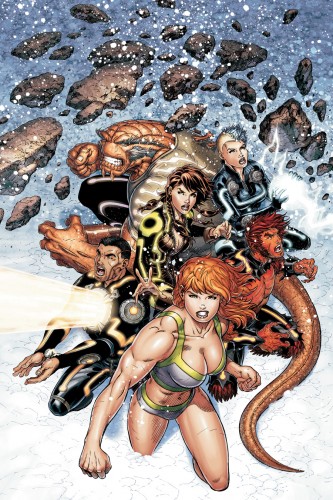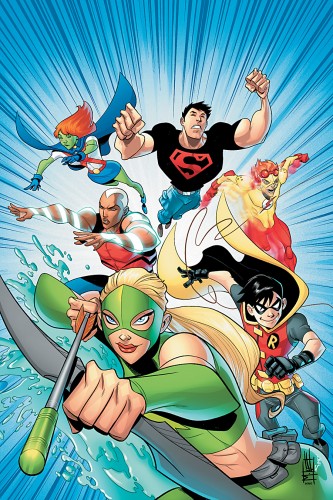Boom! Wham! Pow! The ComiQuad is a column dedicated to the spandex-laden world of comics and superheroes. It goes up each Tuesday and will alternate between comic book reviews and other comic book news. Reviews shall try to be spoiler-free. Zam!
Long explored in the wacky world of comics (and science fiction in general) has been the concept of the parallel universe. For Marvel, there’s the regular universe and the Ultimate Universe (where Peter Parker can die!). For DC, there’s a grand total of 52 different universes (although not all of them are explored) to juggle.
Recently, it has come to my attention that there is one other universe hidden just beyond the dark side of the moon.
What is this universe called, you say? You can call it Earth-53, you can call it the Super-Ultimate Universe, or you can call it Mother if you so please. This mystical place’s true identity, however, is television.
Lost? Fair. Between DC Comics’ upcoming reintroduction of Earth-2 and Marvel’s teasing of more alternate universe characters, it’s easy to get lost in the metaphor.
Over the past year, especially recently with Cartoon Network’s debut of DC Nation, it has become very apparent that the comic book side of DC Comics and the television entertainment side of DC Comics are not friends and are giving each other the silent treatment. This piece will primarily feature DC, since the company has a greater presence in television than Marvel does.
The New 52 Reboot
As one of the most notable events in recent comic book history, DC’s The New 52 franchise-wide reboot was aimed at new readers. A Nielsen survey about the New 52 reported just a few months ago that only 5% of readers surveyed were actually new. The reboot succeeded at grabbing the interest of older males who were already reading comics or who had recently lapsed.
The largest audience from which to obtain new readers is from those who watch superheroes on television. Movie audiences are important, but they don’t establish the relationship with viewers that television shows can.
Three of the most widely visible DC television shows in the past decade were Justice League/Justice League Unlimited, Static Shock, and Teen Titans. If the goal of the reboot were to attract new fans, wouldn’t it be a golden opportunity to capture the fans of those characters?
By and large, the New 52 reboot went out of its way to ignore the fanbases of these television shows.
Justice League and it’s spin-off were led by a triumphant team of seven. Seven months past the reboot and Wally West (the show’s incarnation of the Flash) and Hawkgirl still don’t exist.
Static Shock found a successor in a new comic series Static Shock that bore little to no resemblance to the show. Protagonist Virgil Hawkins left his hometown of Dakota, including any and all recognizable TV show characters, behind for New York City. Eventually a writer/artist civil war and little marketing by DC led to poor sales which resulted in the series’ cancellation.

The most curious TV-to-comics character confusion lies within Teen Titans. In this case, only two of the five protagonists, Robin and Cyborg, were left somewhat visible and similar to their TV incarnations. Starfire, the perennial optimist of the show, is portrayed as a bitter and cold in Red Hood and the Outlaws. Raven and Beast Boy, two fan favorites, still do not exist today. Recent news indicates that Beast Boy will be appearing in The Ravagers in May, but his appearance will be drastically altered. Instead of his iconic green, he is now red.
In short, fans of famous DC show characters had very little to recognize on comic book stands except for Robin, Cyborg, and an enormous pair of orange alien boobs.
That Was Then, This is Now
On March 3, Cartoon Network let loose “DC Nation,” a programming block opened with Green Lantern: The Animated Series, closed with Young Justice, and daintily decorated with a wide variety of DC superhero shorts. Could this return to Saturday morning cartoons pave the pathway between comics and television?

No.
Instead, this clever and fairly successful block of programming has become Earth-53, where all of the missing comic book heroes go to hide. These are the heroes and here are their stories:
- Young Justice: Four (Miss Martian, Artemis, Wally West, Kaldur Aqualad) of the six team members do not exist in comics now, aside from the TV-show based comic Young Justice.
- Green Lantern: The Animated Series: All exist in comics.
- Plastic Man (short): Plastic Man does not exist in comics now.
- Super Best Friends Forever (short): Donna Troy does not exist in comics now.
- Doom Patrol (short): The Doom Patrol does not exist in comics now.
- Amethyst, Princess of Gemworld (short): Amethyst does not exist in comics now.
- DC Nation in Claymation (short): Varied characters, they all exist in comics now.
- New Teen Titans (short): Raven and Beast Boy do not exist in comics now. When Beast Boy does appear, he will look very different.
- Blue Beetle (short): Blue Beetle does exist in comics, but with his current sales, that may not be too likely in the future.
- Thunder and Lightning (short): Black Lightning, Thunder, and Lightning do not exist in comics now. In fact, brand new siblings named Thunder and Lightning will be appearing in The Ravagers, but they are not at all the same characters.
- Doctor Fate (short): Doctor Fate does not exist in comics now.
- Vibe (short): Vibe, to no one’s shock, does not exist in comics now.
Any DC Nation viewer that isn’t a Batman, Green Lantern, Robin, or Cyborg fan will be sorely disappointed to find out that his money is not wanted to purchase comics. Any DC fan who is missing her favorite superhero can take solace in enjoying some Saturday morning cartoons.
The Fate of All the Universes Lies with Earth-53
The results of the Nielsen survey were, to say the least, alarming. Not only did the results reveal that only 5% of readers were new, but that only 2% of readers were under 18.
Two percent belongs on milk. Two percent does not belong on the future generation of the comic book industry. If DC, and the industry as a whole, are not able to drum up interest in younger generations, comics will die. Popular superhero television shows gather millions of viewers, whereas a best-selling comic will maybe sell over 100,000 copies. Comic books need that audience to follow their heroes onto written, and well-drawn, page.
No, the fate of the universe does not rest in the hands of the Justice League. It rests in the sticky hands of Saturday morning cartoon-viewing children everywhere.


Your entire premise ignores the fact that making the comics like the TV shows has historically failed to bring any appreciable audience from TV (or movies) to comics, despite dozens of attempts. You’re basing your argument on a presumption which you then completely fail to support in any meaningful way other than “Well THIS makes sense to ME!” As such, it’s just more pointless armchair quarterbacking.
Oh, and that “Boom! Wham! Pow!” Batman 1966 stuff is a hideous shudder-inducing cliche. Leave that to 1980s “Zap! Pow! Comics Aren’t Just For Kids Anymore!” mainstream newspaper articles.
Hey Aaron,
I would hazard to say that the attempt to bring television and movie fans over to the comic book world hasn’t worked because it’s impossible to do, but instead because no strong attempts have been made. I spent years of my life watching superhero shows/movies, and not once was there ever any attempt to bring me in.
The New 52 is the closest attempt that’s been made, and it wasn’t very well executed in that regard.
It is possible for television and comics to have huge, successful influences on one another.
I’d use Harley Quinn as a case study. She started as a minor, new character on Batman: The Animated Series, crossed over to comics, and has eclipsed many classic characters decades older than her in popularity. Thanks to her popularity on television, she’s been accepted as a major player in the Batverse.
Going into the reboot, I knew plenty of people who wanted to try on comics for this first time. Unfortunately, few of the characters the knew from TV were in the reboot. In turn, DC did not get their money.
The two audiences don’t need to be as separate as they are.
I knew the new 52 was a bad idea. I’ve looked at a few of these books, and the only ones I’m really reading on a regular basis are the Green Lantern books, which somehow emerged from the reboot completely unchanged. And thank god for that.
Kaldur isn’t in the comics anymore? Huh? Didn’t they just introduce him there like last year?